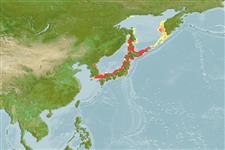Common names from other countries
分類 / Names
俗名 | 同種異名 | Catalog of Fishes(屬, 種) | ITIS | CoL | WoRMS | Cloffa
Teleostei >
Salmoniformes (Salmons)
鮭形目 (Salmons) >
Salmonidae (Salmonids)
鮭科 (Salmonids) > Salmoninae
Etymology: Oncorhynchus: Greek, onyx, -ychos = nail + Greek, rhyngchos = snout (Ref. 45335).
Environment: milieu / climate zone / depth range / distribution range
生態學
海洋; 淡水; 半鹹淡水 底中水層性; 溯河洄游 (Ref. 51243); 深度上下限 0 - 200 m (Ref. 50550). 溫帶; 65°N - 34°N, 127°E - 158°E
Northwest Pacific: Japan and adjacent waters.
西北太平洋: 鄂霍次克海與日本海; 日本北部與韓國半島東部。
大小 / 重量 / 年齡
Maturity: Lm ? range ? - ? cm
Max length : 79.0 cm TL 雄魚/尚未辨別雌雄; (Ref. 56527); 最大體重: 10.0 kg (Ref. 9988)
The fluviatile form generally inhabits headwaters and often maintains a territory; it feeds mainly on insects but also on small crustaceans and fishes. The sea-run form goes downstream forming schools, and after a short stay in the brackish zone enters the sea where it feeds on small fishes and pelagic crustaceans. Oviparous (Ref. 205). Eggs are buried in unguarded nests (Ref. 205). Marketed fresh and frozen; eaten broiled and baked (Ref. 9988).
生活在河中的形式通常居住於河川源頭而且時常維持領土; 它主要捕食昆蟲也捕食小型甲殼動物與魚。 海洋迴游的形式去向下游形成群體, 而且在一個短停留在中之後,半鹹淡的區域進入海洋在那裡它吃小魚與大洋性甲殼動物。 卵生的.(參考文獻 205) 卵被埋藏在沒有防衛的巢之中。 (參考文獻 205) 在市場上銷售生鮮和冷凍; 吃火烤與燒烤的.(參考文獻 9988)
Distinct pairing (Ref. 205). Reproductive strategy: synchronous ovarian organization, determinate fecundity (Ref. 51846).西北太平洋: 鄂霍次克海與日本海; 日本北部與韓國半島東部。
Masuda, H., K. Amaoka, C. Araga, T. Uyeno and T. Yoshino, 1984. The fishes of the Japanese Archipelago. Vol. 1. Tokai University Press, Tokyo, Japan. 437 p. (text). (Ref. 559)
IUCN 瀕危狀態 (Ref. 130435)
瀕危 (A1ac; B2abcde+3abd); Date assessed: 01 August 1996
CITES (Ref. 128078)
Not Evaluated
人類使用
漁業: 商業性; 養殖: 商業性; 游釣魚種: 是的
工具
特別的報告
下載 XML
網路資源
Estimates based on models
Preferred temperature (Ref.
115969): 0.3 - 16.5, mean 3.3 (based on 86 cells).
Phylogenetic diversity index (Ref.
82804): PD
50 = 0.5000 [Uniqueness, from 0.5 = low to 2.0 = high].
Bayesian length-weight: a=0.00955 (0.00605 - 0.01506), b=3.03 (2.90 - 3.16), in cm Total Length, based on LWR estimates for this species & Genus-body shape (Ref.
93245).
營養階層 (Ref.
69278): 3.6 ±0.59 se; based on food items.
回復力 (Ref.
120179): 中等的, 族群倍增時間最少 1.4 - 4.4年 (tm=4; tmax=6; Fec=1,000).
Fishing Vulnerability (Ref.
59153): Moderate to high vulnerability (52 of 100).
Climate Vulnerability (Ref.
125649): Moderate to high vulnerability (49 of 100).
